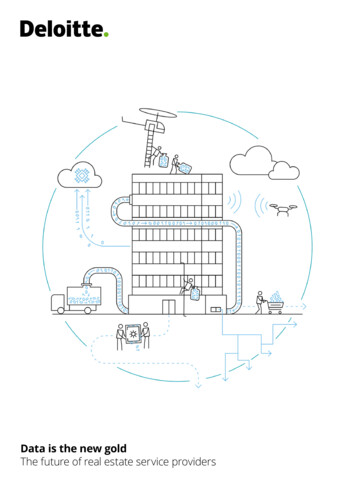
Transcription
Data is the new goldThe future of real estate service providers
Table of contents2Introduction03A glimpse into the future04Transformation through technological innovations05Digitalization in new construction and existing buildings09Transformation through modified user behavior11Big data determines the industry’s future14The skills of tomorrow’s real estate manager18Conclusion20
Data is the new gold1. IntroductionTechnological change affects everyone. It alters our daily lives at every level: social, economic, andpolitical. Unitl now, the real estate industry’s reaction to these fundamental changes has been muted,even though real estate’s vulnerability to digital disruption is as profound as any other industry.1The results of the Deloitte Global study, “Industry 4.0: Are you ready?,” show that technologicaldevelopment and mobility will require consumers and employees to adapt the way they live, work, andconsume.Price pressure and fierce competition are a powerful catalyst for introducing technological innovationsto building technology. These drivers – combined with the growing importance of data – are poised toupend business models and introduce new players in the market.For real estate service providers, the imperative is to address two key questions: What drivers and trends will decisively impact the future of real estate services? How should real estate service providers adapt their business models and services in order toremain successful going forward?Real estate service providers can stay ahead of the curve by working with clients to develop andimplement effective strategies to meet the demands of tomorrow. In this report, we look at somescenarios for how these changes can play out, along with ways that real estate service providers canrespond to them.3
Data is the new gold2. A glimpse into the futureIn the world of real estate, a growing number of deals rely on data analysis. From faster, more accurateappraisals to sophisticated forecasts, the use of analytics can lead to smarter decisions about propertyinvestments.Considering all the data that real estate and its users generate, it seems likely that companiesspecializing in big data processing will enter the real estate services market. These “data collectors”enjoy competitive advantages such as innovative employees and established, data-supported businessmodels. They also have the cash to acquire companies and technologies that can help them break intonew markets. Attributes like these put big data companies ahead of many incumbent firms, which facea learning curve in adopting data as a business model.Fig. 1: Large quantities of data make the market attractive to new players from the technology industrySo far, the business case hasn’t been strong enough for technology and data companies to make aconcerted entry into real estate services. But they’re forming partnerships and alliances. They’ve alsoshown a keen interest in building systems automation for newly-constructed and existing buildings.Specific examples include Alphabet (Nest), Samsung (SmartThings), and Amazon (Alexa). The upshot?Although these companies initially took their large-scale, billion-dollar investments to the residentialmarket, the commercial market is the next logical step.If big data companies take over technological development in the real estate services industry, assetand property managers may lose significant influence—not only in shaping the work environmentgoing forward, but over their own business model as well. To maintain their hold on the customerrelationship, real estate service providers may need to reinvent their value proposition and make itcrystal-clear to the customers they serve.4
Data is the new gold3. Transformation throughtechnological innovationsLet’s look at some of the more significant innovations affecting theconstruction, use, and management of real estate.RoboticsBetween rising wages and improving automation, robotics isbecoming an attractive alternative to today’s labor-intensive services.Applications include: Surface cleaning Security services Façade cleaning or painting (by drones) Inspection of hard-to-reach exteriors (e.g., transmitter masts)As these examples show, automatic service robot applications arecurrently aimed at tackling simple, large-scale tasks. Eventually,however, they may take on more complex work, including socialfunctions such as reception or sales. This could upend the personnelstructure of real estate service providers.It’s possible that robot manufacturers may not be content to remainsuppliers to real estate service companies, putting real estate serviceproviders’ share of the building services market at risk. Incumbentproviders might head this off by offering services related to the useand maintenance of robotics components. Another option could be toprovide the robotic labor themselves via performance-based serviceagreements. This would require developing the skills to consistentlyprovide well-functioning robots.Augmented and virtual realityWearables and AR/VR devices are a significant driver of innovationin facilities management – especially when it comes to the mobileworkforce.AR/VR aids in the visualization of technical components. It also plays animportant role in locating defective components. AR/VR devices candisplay corresponding system information directly in the field of viewand, when walking around the building, provide location-specific dataas well.5Key termsRoboticsRobotics encompasses IT, kinetics, electricalengineering, and mechanical engineering. It involvesthe use of sensors, actuators, and informationprocessing to create robots that are able to interactwith their physical environment.Augmented and virtual reality (AR/VR)AR/VR renders a computer-generated, virtual worldthat simultaneously detects reality in real time.Sensory impressions such as scent, sight, or soundcan give the user a feeling of presence in the virtualroom.Sensor technologySensor technology refers to the use of sensors tomeasure and monitor changes in the environment.The sensors convert non-technical stimuli intoelectric signals for data processing.Internet of Things (IoT)IoT refers to the interconnection of physical,intelligent objects in an Internet-based structure. IoTtechnologies enable different types of end devicesto record data and communicate via the Internet.Building information modeling (BIM)BIM is the digital rendering of a building’s physicaland functional features. BIM systems can alsoinclude cost structures and temporal componentsthat help optimize building planning, design, andmanagement.
Data is the new goldIn the long term, augmented reality is likely to diminish the need not only for labor but for hardcopyplans and documents as well. Consider the challenges of extrapolating three-dimensional reality out oftwo-dimensional architectural drawings, particularly when it comes to hard-to-reach components suchas pipes, ducts, false ceilings, and underground construction. Augmented reality, combined with datasuch as digitalized building models, can make these and other hidden compontents visible – similar tox-ray glasses.Meanwhile, AR/VR is shaking up administrative functions such as order planning and processing. Thetechnology (in conjunction with geoinformation systems) makes it easier to carry out live tracking ofemployees, route optimization, and resource planning based on technicians’ skills and availability. Itcan also close gaps in onsite expertise by bringing in remote technicians via teleguidance. Finally, AR/VR can optimize supply chains – including product management and logistics – directly through theenterprise resource planning system, freeing onsite employees for higher-value work.As with robotics, real estate service providers may have to become increasingly involved with operatingand maintaining the corresponding systems if they aim to retain market share in this area.Sensor technologySensors form the foundation of data-driven real estate services. They’ve become widely available,with prices about half of what they were just five years ago.2 Sensors can free providers from rigidprocesses, enabling them to adapt their services on an as-needed basis.A bridge, for example, might have sensors that enable remote monitoring of its condition. If someaspect of its condition falls below a certain threshold, the sensors trigger an alarm, prompting thedispatch of a repair technician or crew. Similarly, sensors can help real estate service providerspinpoint trouble spots, identify their causes, and order repairs all at one go. By analyzing thedata gathered through sensors—date of last maintenance, for instance, or day-to-day resourceconsumption—providers can also align their services more closely with the user’s requirements,improving customer satisfaction.Sensors offer efficiencies in other areas besides maintenance and repairs. An intelligent climatecontrol system can recognize when users leave the room, adjusting the heating or cooling in response.Lighting controls can automatically adapt to personal requirements. And then there’s the abilityfor sensors to provide location-specific information such as floor plans, operating instructions fortechnical office equipment, or the number of people inside. This can help services providers with avariety of planning, from meals in the building’s cafeteria to evacuations in case of an emergency.6
Data is the new goldInternet of ThingsThe Internet of Things (IoT) is made up of everyday objects embedded with sensors and othertechnology that allow them to pick up data and pass it on to other objects. For instance, that intelligentclimate control system mentioned earlier might also detect debris and deploy housekeeping robots forcleaning. Similarly, sensors in potted plants could communicate with automated watering systems. IoTis the underlying principle of intelligent building automation.According to the International Energy Agency, IoT technology could lower the energy consumptionof residential and commercial buildings globally by as much as 10 percent between 2017 and 2040.3It could reduce workloads for real estate service providers as well. Imagine vehicles turned intomobile high-tech workshops, equipped for any contingency and avoiding empty runs due to a lackof replacement parts or tools. Intelligent data linking provides all necessary building informationfor route planning. Even more futuristic: If a replacement part doesn’t fit or isn’t available, it can beremanufactured via 3D printer.Building information modelingBuilding information modeling (BIM) uses 3D models to show what a facility looks like and how itfunctions. This digitized construction offers a way to complete onstruction projects more efficiently,keeping them within the specified timeframe and budget. It also supports building management byproviding precise information around structure, piping, cable paths, and obstructed facilities.In the future, real estate service providers will have to be able to analyze complex BIM options anduse them to benefit property users and owners. Bear in mind that BIM is a key step in the ongoingdigitization of all building information related to planning and implementation. Put another way, BIM’svirtual building model can serve as a data foundation for tomorrow’s digital service model.Robotics, AR/VR, sensors, IoT, BIM – eventually, the real estate services industry will take up all of thesetechnologies. But how quickly will existing inventory become digital building inventory?7
Data is the new goldPredictions1.New technologies significantly affect the real estate industry.2.Robotics and its end products (robots, drones, etc.) become increasingly important to facilities management. The relationship between people (employees) and technology gain increasing sensitivity.3.New technologies continue to attract new players to the market. Real estate service providers consider integrating technology among their services so they become harder to replace.4.Greater availability of building and user data leads to an inc8
Data is the new gold4. Digitization in new constructionand existing buildingsIn the previous section, we introduced the major technical innovations affecting real estate services.What’s striking is how, up to now, most have remained at the industry’s periphery. Why? For one thing,real estate services have been profitable (though low-margin) businesses for decades. So the pressureto adopt new technologies hasn’t been strong. But what would happen if real estate did become moredigital?Digitally-optimized new constructionModern building management thrives on new construction – as well as comprehensive renovationsand innovative construction techniques. For that reason, internet-connected sensors and deviceshave quickly become a competitive requirement for commercial real estate owners. By 2020, Gartnerestimates, there will be over 20 billion connected IoT devices with roughly 2.5 billion sensors in smartbuildings.4Cities where demand for real estate is greatest will be the first to outfit for new technology. Thanks tohigher rents, investment costs for new buildings and modernizations might be higher as well. In anycase, the result will be an expectation of rapid technologization, particularly in city centers.As the technologies described in the previous section become more important to building planning andconstruction, real estate service providers will have a chance to distinguish themselves via digitization.The best example of this is BIM, which opens the door for real estate service providers to get involvedduring the first phase of the property lifecycle and optimize the building in view of later serviceconcepts.Digital upgrading of existing buildingsIt’s hard to forecast the demand for turning existing buildings into smart buildings. But it’s easy to seethat existing buildings, because there are more of them, offer greater potential for digitization than newbuildings.And smart building solutions are multiplying. One example is indoor navigation, which uses GPS-liketechnology to help users find their way around. In another application, a specially-equipped vehiclecan drive through a building, record up to 50,000 square feet per hour, and immediately render theinformation in 3D. Besides navigation, this also helps with measuring the building and processing datafrom CAD and BIM programs. According to Deloitte Global, by 2022, at least a quarter of all uses ofprecision digital navigation are predicted to include an indoor leg or an entirely indoor journey.5A second type of solution is climate control. The Semperoper, an opera house in Dresden, Germany,offers an example of this. Severely damaged by flooding in 2002, the Semperoper has since beenoutfitted with sensors that track changes in the fabric of the building. These include temperature andmoisture at certain locations. Sensors transmit data wirelessly because cable installation is disallowedin the historic building.69
Data is the new goldAs the technology for smart building matures, it will likely find applications among regular householdsand commercial properties as well. For instance, real estate service providers might use sensors inshopping malls to directly connect with owners and offer services to end customers. The result could bestronger tenant engagement and customer relationships.Ultimately, the cost-benefit ratio will determine how quickly existing building inventory goes digital. Sincethe investment is more likely to pay off in highly sought-after locations, that’s probably where we’ll seethe first wave of digitization.For real estate service providers, another potentially disruptive aspect of digitization is the flow of datafrom building users. Could this data become a second source of revenue in the future?Predictions1.Relative to newly-constructed buildings, the existing building inventory offers even greater marketpotential for digitization. Technologies that are purpose-built for existing buildings are implementedmore frequently in the future.2.Big cities see the greatest digitization of newly-constructed and existing buildings, thanks to a morefavorable cost-benefit ratio.3.With the arrival of new technologies in building construction and operation, even real estate serviceproviders increasingly have to deal with new, downstream technological developments.10
Data is the new gold5. Transformation throughmodified user behaviorSo far, we’ve discussed a number of technologies and their applications in the real estate industry. Butnot everything that’s technologically possible ends up being implemented. Only the applications thatprovide a building’s users with added value – or enable owners to engage in marketing or optimizereturns – will get the necessary investment.In order to become a value-added integrated service provider, it’s important to understand how userrequirements might change over time. This way, providers can continue offering services that are in linewith the demand. Consider the office sector, where users (employers as well as employees) have everincreasing requirements around flexibility and space optimization.The Deloitte Global study “Global Human Capital Trends 2018” outlines disruptive changes that demandefficient flexibility and radical innovation from companies. In today’s networked organizations, acombination of technology, physical space design, new leadership approaches, and new work practicesmust all come together to achieve this goal. This requires collaboration among HR, IT, and the businessto build an integrated, customized work environment. Adaptable and flexible workspaces are one key toenabling productivity.7There is a trend towards offices with a residential feel, so the office becomes a place where people wantto hang out as they would at a trendy coffee shop or, indeed, on their sofa at home. It is believed thatdiverse environments are key to fostering a collaborative and creative work environment.8As technology becomes more integrated, mobile devices and modern infrastructure is a requirementand will pave the way to work from nearly anywhere in the future. Pressure from employees for greaterfreedom and flexibility means that companies will have to address an increased demand for mobile,technological equipment, and modern workplace concepts. Attractive, innovative conditions are anessential element of success for modern companies in the current war for talent.This approach isn’t new. It became a trend in the 1990s. While the initial aim was to economize spaceby having employees share workspaces, more recently society has embraced simultaneous communalwork and use of infrastructure (coworking) to improve work quality even beyond the borders of thecompany. Thanks to new technologies that make a flexible, variable workplace relocation technicallypossible, and even socially appealing, this development has once again picked up speed. Thus, theinventory of coworking proposals grew in the last three years by 72 percent to roughly 13,800 officebuildings.911
Data is the new goldInformationSensors record themovements ofemployees within theoffices.AnalysisDifferent sensorsidentify patterns inworkplace use andstaff interactions.Well-beingKnowledge ofemployee behaviorincreases well-being.SecurityLinked systems raisethe effectiveness ofsecurity andemergency responseplans.MotivationPleasant, custom-madeworkspaces contributeto increasedmotivation andproductivity.Fig. 2: Possible effects of technological development on office real estateRegardless of office style, providers are optimizing these spaces through data-supported spacemanagement. An appointment calendar automatically reserves conference rooms and, in the morning,sends directions to the nearest available workspace via the user’s phone. This requires movementtracking software/tools.On-demand spaces offer additional potential for flexibility. If employees cannot or do not want to gointo the company’s location, they can use an app to book a prepared, equipped workspace for use in abuilding that’s not completely occupied. Locations could also include airports and train stations.In these respects, technological progress will bring conceptual diversity and geographic distribution tooffice life. Day-to-day work is becoming more mobile and virtual. With increasing spatial separation, theimportance of connectivity among colleagues will continue to rise.In the future, it will become more and more important to link employees by means of a stable andinnovative technical infrastructure and to support collaboration. As a result, it will be essential tomonitor and use the volume of data created. This likely will hold true across all types of commercialuse. For example, in retail stores, digital transformation will bring new technologies such as smarttagging/smart checkout, innovative user-friendly experiential stores, seamless payments, andimproved customer experience.10RecognizeBeacons recognizeusers and display theCRM profile plusbrowser historyaccordingly.InspireEvery customer has apersonalized homescreen and receivestargeted special offers.InformEasy access to productinformation andratings helpscustomers makedecisions aboutpurchases.Fig. 3: Effects of technological development on retail real estate12ManageAs soon as a product isselected, a map takesthe customer directlyto the desired item.AccelerateAt the end of thepurchase, thecustomer can pay viaan app and avoidwaiting at thecheckout.
Data is the new goldPredictions1.New technologies significantly change the use of real estate, ushering in space efficiency, flexibility,and qualitative improvements for office users.2.Declining demand for space (and the associated trend toward a rental market) plus an ongoing warfor talent drive the modernization of existing spaces.3.Technological outfitting – along with collaborative, digital office concepts – become a significant leverfor office space providers, as well as for employers’ intent on standing out from the competition.4.These trends likewise affect all other commercial types of real estate, fundamentally changing usageas a result.5.Real estate service providers become familiar with new technologies. They highlight their technicalprowess in order to maintain market share.13
Data is the new gold6. Big data determines theindustry’s futureBetween technology and the increasing requirements of users and owners, personal and buildingrelated data will accumulate on a large scale. Those who can use this data in a profitable way will bewell-positioned for future success.The near futureAs networking technology continues to advance, it’s likely to create increasing amounts of data aroundbuildings, their use, and their users. At the same time, opportunities to derive practical knowledge andfrom this data are on the rise. If it’s possible to systematically compile and analyze data from all relevantaspects, then entirely new applications for operating, leasing, financing, and purchasing real estate willcome into being.In addition to declining demand for space and emerging user requirements for technical infrastructure,data produced on the property – as a potential additional source of income – will be a driving force foradapting existing spaces to modern needs.New competitorsReal estate is already an enormous source of data today, and it stands to become even more so in theyears ahead. This holds both risks and opportunities. Potential competitors from the technology sectormay have an advantage due to their existing business models for the profitable use of big data. It’s asafe assumption that theywill further refine this capability and gear it toward obtaining and using realestate/user data.The entry of important actors from outside the industry – a process already underway – can have majoreffects on the sector’s market structure. The market is gradually expanding in the direction of complex,interconnected, high-tech, and automated services. Here, well-financed and technologically-leadinggeneralists that can offer a standardized global service strategy will be in a position to solidify theircompetitive advantages.New business modelsThe opportunity for real estate service providers is that they currently sit at the data source. If doneright, they can enjoy a competitive advantage in setting up data-driven services and staying in contactwith users, owners, and the property itself. But what would this business model look like?14
Data is the new goldMost likely, it would focus on combining information at the building, service, and market levels. Withthe rising prevalence of BIM, along with sensors in systems engineering and in rental spaces, increasingamounts of data will appear. This data will contain insights about the operation, capacity utilization, andcondition of the building and the systems installed in the building. As a result, owners and users willincreasingly expect preemptive detection of technical malfunctions. Real estate service providers alsowill have to guarantee the building’s reliability of performance as a minimum requirement.At the service level, providers can bundle a customized service package by means of data analysis.This can be a more effective way to look after real estate users and owners. It can also be a moreefficient way to arrange service delivery (versus customized maintenance intervals and optimized routeplanning).In general, providers will have to determine who uses what, and how, in a way that serves users andowners while shoring up the competitive position of today’s real estate managers.In addition to cost- and benefit-optimized use of real estate for customers, different operator modelscan be simulated in detail based on data analysis before a purchase decision, with crucial parametersrelated to financing and marketing as part of the analysis. In the future, with the complete networkingof property, it may be possible to carry out technical due diligence reviews semi-automatically sincethe technical history and the current condition of the components can be generated automatically viaBIM. Reviews from technicians, lawyers, and advisors – not to mention uncertainty on the parts of bothbuyers and sellers – can be reduced to a minimum, with real estate service providers potentially takingup some of the effort directly.A strategic partner to owner and usersReal estate service providers – the ones who deliver user-centric services and defect-free buildings – arelooking after satisfied customers. They can use insights from their data to help their actual customers,the real estate owners. In fact, besides its ability to increase customer satisfaction, lower turnover rates,and reduce cost, a capacity for structured data analysis can help to position providers as a strategicpartner in optimizing and stabilizing returns.This kind of partnership is essential to tomorrow’s real estate service providers. Along with owners andusers, they will be responsible for the quality and effectiveness of technology and strategic concepts.This means a higher bar for performance but also an opportunity to improve margins. It’s likely thatperformance-based remuneration for services will become an option.15
Data is the new goldTraditional offeringsNew offeringsTechnicianConventional building servicesInstructor/trainerAssumption of high-tech repair andother servicesInstruction and training in handling andmaintaining technological building equipmentBrokerData protection specialistOperation of an integrated spacemanagement systemRequirement for building-specific andtransparent quotation costingPreparation of an optimal renter portfolioIT expertData analysis, including guaranteed protectionof personal user dataConceptualization of optimal usage modelsData analystInstallerData protection guarantee with regardto building dataConceptualization of an optimizedoperator modelMediatorOptimization of retail and office spacesStrategic partnerAssumption of operator risksFig. 4: The future roles of real estate service providersThe battle against access to dataData is an essential component of tomorrow’s business foundation. But benefiting from it will requiresettling the question of who controls the data. Legitimately and understandably, both owner and userwill claim the right to “their” data.Under those circumstances, real estate service providers have a few options. One is to own and operatethe relevant technological systems themselves. However, this would be a significant investment.The more obvious solution is to intensify the collaboration with users and owners. Digitization meansintegration and networking. Issues, tasks, and business models become more intertwined, requiringspecific know-how and skills. If providers want to avoid handing over these services (and control overthe data) to third parties, they must develop the appropriate expertise through their own employees orcompany partnerships. Once these are in place, they can set about establishing the infrastructure andarchitecture they need without losing control over the data.16
Data is the new goldRegulatory hurdles to data useData security will have a decisive impact on the success of new business models. Part of this will involvemodernizing and adapting data protection provisions. That said, how much providers can transformtheir business models remains to be seen (particularly with processing of personal and movementrelated data, which requires anonymization). There are repeated examples of the collision of digitalprogress with regulations. For example, in Germany the introduction of Google’s Street View was muchpostponed due to violation of privacy rights. Ultimately, Google threw in the towel – they would nolonger update the images despite high demand.Another important issue: Building user privacy. Privacy is a key priority due to all the data that sensorscollect. IoT should make buildings user-friendly; only employees should a
remanufactured via 3D printer. Building information modeling Building information modeling (BIM) uses 3D models to show what a facility looks like and how it functions. This digitized construction offers a way to complete onstruction projects more efficiently











